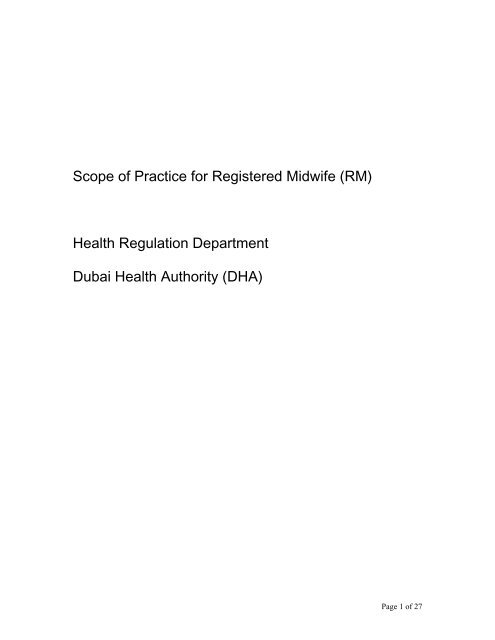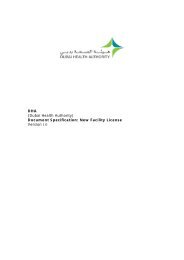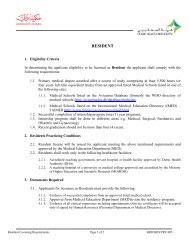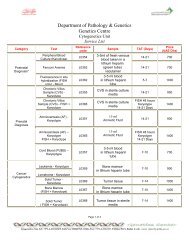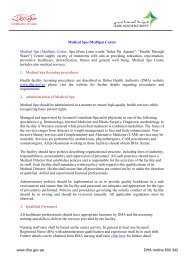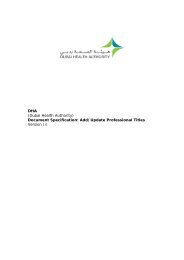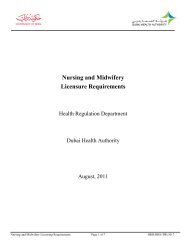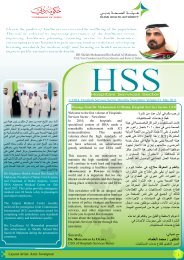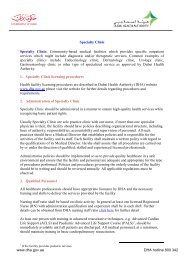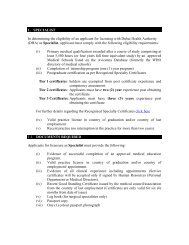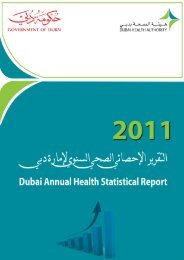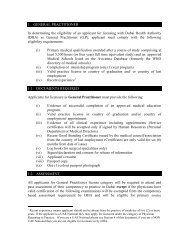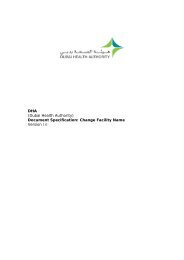Registered Midwife - Dubai Health Authority
Registered Midwife - Dubai Health Authority
Registered Midwife - Dubai Health Authority
Create successful ePaper yourself
Turn your PDF publications into a flip-book with our unique Google optimized e-Paper software.
Scope of Practice for <strong>Registered</strong> <strong>Midwife</strong> (RM)<strong>Health</strong> Regulation Department<strong>Dubai</strong> <strong>Health</strong> <strong>Authority</strong> (DHA)Page 1 of 27
Introduction<strong>Health</strong> Regulation Department in DHA is responsible for regulating midwifery practicein the Emirate of <strong>Dubai</strong>, United Arab Emirates. Scope of Practice (SOP) refers to theactivities that registered midwives are educated, authorized and competent to perform aswell as their decision making capacity. Such activities are established through thelegislated definition of licensed midwifery practice, complemented by standards, limits,conditions and education and influenced by setting, environment and health needs of thepopulation. The Eastern Mediterranean Region (EMRO) of the World <strong>Health</strong>Organization (WHO) in its Global Advisory Group Meeting in 2000 identified lack oflegislation as the most prevailing reason for nurses and midwives not working to their fullpotential.The primary purpose of this document is to guide and direct midwives practice withinthis environment. Through this framework DHA health regulation meets its responsibilityto regulate midwifery practice in the public interest and address incompetent, impaired orunethical practice amongst midwives. DHA health regulation in recognising its furtherresponsibilities to ensure public safety and in line with its published expectations of theregistered nurse, equally expects that registered midwives must self assess theircompetence and make individual decisions about their practice within uniquecircumstances and settings. Furthermore midwives retain accountability for their ownpractice and are accountable to the woman and her newborn, the public, their employerand the regulatory authority.To ensure consistency in midwifery standards throughout the UAE the following<strong>Midwife</strong>ry Competency Framework has drawn largely on the work undertaken in 2007 todevelop the Scope of Practice (SOP) for the <strong>Midwife</strong>, which was endorsed by the <strong>Health</strong><strong>Authority</strong> of Abu Dhabi (HAAD) Nursing and <strong>Midwife</strong>ry Advisory Committee inDecember 2007 and the Federal Department of Nursing (FDON) <strong>Midwife</strong>ry Committeein January 2008. During the collaborative development of the SOP by midwiferyrepresentatives throughout the UAE, the International Confederation of Midwives (ICM)Essential Competencies for Basic <strong>Midwife</strong>ry Practice (2002) provided an internationalguide and benchmark. In order to provide more detailed evidence guidelines formidwifery practice in <strong>Dubai</strong> the <strong>Midwife</strong>ry Competence Framework has been modifiedand expanded.The Scope of Practice for the Licensed <strong>Midwife</strong> is endorsed by DHA health regulationand should be read in conjunction with DHA health regulation Code of Conduct andEthics for Nurses and Midwives.DHA health regulation upholds that no midwife should be directed or compelled toundertake any practice that falls short of DHA health regulation standards or code ofconduct requirements.Page 2 of 27
International Definition of a <strong>Midwife</strong>As accepted by the ICM Membership and Joint Study Group on Maternity Care, FIGO,WH0A midwife is a person who, having been regularly admitted to a midwifery educationalprogram, duly recognized in the country in which it is located, has successfullycompleted the prescribed course of studies in midwifery and has acquired the requisitequalifications to be registered and/or legally licensed to practice midwifery.The sphere of practice: She must be able to give the necessary supervision, care andadvice to women during pregnancy, labour and postpartum period, to conduct deliverieson her own responsibility, and to care for the newborn and the infant. This care includespreventive measures, the detection of abnormal condition in mother and child, theprocurement of medical assistance, and the execution of emergency measures in theabsence of medical help.She has an important task in counseling and education, not only for the women, but alsowithin the family and community. The work should involve antenatal education andpreparation for parenthood and extends to certain areas of gynecology, family planning,and child care.She may practice in hospitals, clinics, health units, domiciliary conditions or any otherservice.Competency StandardsFour Domains of Practice have been identified. Core midwifery competency standardsand associated performance criteria are located within these domains of practice whichare guided by the ICM/WHO/FIGO (1992) and ICM (2005) Definitions of the <strong>Midwife</strong>and the ICM essential competency standards for the <strong>Midwife</strong> (2002).Domains of Practice1. <strong>Midwife</strong>ry Practice and Comprehensive Care2. Professional, Legal and Ethical Practice3. Professional Development4. Quality Improvement and Collaborative <strong>Health</strong>carePage 3 of 27
Competency StatementsEach Domain of Practice has competency statements and associated performance criteriathat a midwife must demonstrate to fulfil regulatory requirements.Evidence of safety to practice is demonstrated when the registered midwife meets thecompetency criteria within the domains.The indicators and evidence guides are neither comprehensive nor exhaustive but ratherprovide examples of evidence of competence.NB: For the purpose of this document she may mean he in specific circumstancesPage 4 of 27
Domain 1 <strong>Midwife</strong>ry Practice and Comprehensive CareCompetency 1.1 Promotes health and provides education to the woman and her familyIndicator Sub Indicator Evidence Guide Examples1.1.1 Midwives provide highquality, culturally sensitivehealth education and services tothe woman and her family inorder to promote healthy familylife, planned pregnancies andbirth spacing and positiveparenting.1.1.1.1 Identifies, participates in and contributes to the development ofhealth education programs in the community1.1.1.2 Provides the woman and her family with accurate information1.1.1.3 Supports the woman and her family to promote health and wellbeingKnowledge of:• Communication in establishing andmaintaining helpful relationships• <strong>Health</strong>y life style behaviours• Positive parenting strategiesPage 5 of 27
Competency 1.2 Facilitates decision-making by the woman and her familyIndicator Sub Indicator Evidence Guide Examples1.2.1 Midwives provideevidence-based information tothe woman and her familyfacilitating them to makeinformed choices regarding theircare.1.2.1.1 Offers advice and midwifery care that respectsthe cultural and social needs of each womanand her family1.2.1.3 Communicate relevant information effectively, using language thatis readily understood1.2.1.4 Actively listens to the woman and her family and responds to theirneeds1.2.1.5 Facilitates learning opportunities through sharingof information1.2.1.5 Advocates informed choice and shared decision-makingKnowledge of:• The effect of culture oncommunication, such as whenphysical contact is appropriate andwhen it is not and how to addresspeople• The different forms and range ofeffective communication, includingverbal and non-verbalcommunication, touch, symbols andimages• Theories that inform and enhanceunderstanding of communication andthe effective use of relationship andinterpersonal skillsPage 6 of 27
Competency 1.3 Provides safe and effective antenatal careIndicator Sub Indicator Evidence Guide Examples1.3.1 Promotes the health andwell-being of the pregnantwoman and the fetus1.3.1.1 Plan, implement and evaluate holistic antenatal care incollaboration with the woman and her family1.3.1.2 Educates the woman and families about normal physiologicalchanges of pregnancy and advise on strategies to relievecommon discomforts1.3.1.3 Assesses the growth and well-being of the fetus1.3.1.4 Provides nutritional advice for pregnancy and lactation1.3.1.5 Interprets and acts upon information from antenatalassessments1.3.1.6 Interprets and analyses basic screening laboratory/ultrasoundstudies1.3.1.7 Identifies health risk factors and refers care as necessaryKnowledge of:• Commonly used clinical protocols,pathways, assessment frameworks andmaternity care guidelines.• The importance of giving constructive,positive feedback to others• Factors that impact positively andnegatively on women’s duringpregnancy and well-being.• The physiological changes that occurduring pregnancy & their impact onhealth.• Care for the pregnant woman fromconception to birth• Care for the normal newborn• Potential risk factors duringpregnancy.Page 7 of 27
Competency 1.3 Provides safe and effective antenatal careSub Indicator Evidence Guide Examples Evidence Guide ExamplesKnowledge of:1.3.2 Prepares the woman forlabour, birth and parenting1.3.2.1 Educates the woman about the onset and process of labour1.3.2.2 Provides information about pain relief, birth positions and deliveryoptions to facilitate informed choices1.3.2.3 Protects, promotes and supports breastfeeding in alignment withcurrent WHO/UNICEF guidelines• Care of the woman during labour• Pain relief during labour• Baby Friendly AccreditationguidelinesPage 8 of 27
Competency 1.4 Provides safe and effective intrapartum careIndicator Sub Indicator Evidence Guide ExamplesKnowledge of:1.4.1 Demonstrates anunderstanding of the physiologyof labour1.4.1.1 Recognizes the relevant critical diameters and landmarks of thematernal reproductive anatomy1.4.1.2 Identifies the signs which indicate onset and progress of labour1.4.1.3 Identifies the measures to assess fetal and maternal well-being inlabour1.4.1.4 Identifies the signs and indicators of deviations fromnormal/complications• The physiology of normal labour• Evidenced based midwifery skills forappropriate interventionsPage 9 of 27
Competency 1.4 Provides safe and effective intrapartum careIndicator Sub Indicator Evidence Guide ExamplesKnowledge of:1.4.2 Demonstrates competencyin the skills needed to supportthe woman during childbirth1.4.2.1 Promotes normal physiological childbirth1.4.2.2 Identifies complications or deviations from normal1.4.2.3 Implements midwifery care which reduces risk and harm to thewoman and fetus1.4.2.4 Encourages and respects the woman’s preferencesthroughout labour and delivery, within safe parameters of practiceor safe delivery in an environment conducive to well being ofmother and newborn as requested1.4.2.5 Recognizes emergency situations and intervenes in an appropriateand timely manner.• Support for the woman during labourand delivery• Evidenced based midwifery skills forappropriate interventions duringemergency situations• Advocacy• Informed consentPage 10 of 27
Competency 1.5: Provides safe and effective postnatal careIndicator Sub Indicator Evidence Guide Examples1.5.1 Demonstrates anunderstanding of the physiologyof the post natal period1.5.1.1 Identifies the normal process of involution and healing followingchildbirth1.5.1.2 Facilitates the process of lactation and bonding, supporting themother-newborn dyad1.5.1.3 Recognizes maternal nutritional, physiological and emotionalneeds and acts accordingly1.5.1.4 Educates the woman about discomforts of the puerperium andadvises on strategies to relieve them1.5.1.5 Recognizes deviations from normal and acts accordinglyKnowledge of:• Physiology of the post natal period• Care of the mother and new bornpost partum.• Evidenced based midwifery skills forappropriate interventionsPage 11 of 27
Competency 1.6: Provides safe and effective care of the newbornIndicator Sub Indicator Evidence Guide Examples1.6.1 Demonstrates aknowledge of the physiologyand needs of the newborn1.6.1.1 Recognizes signs of newborn adaptation to extra-uterine life1.6.1.2 Identifies factors relevant to growth and development1.6.1.3 Identifies variations in the normal newborn and acts accordinglyappropriately1.6.1.4 Implements health promotion and disease prevention strategiesKnowledge of:• Physiology and needs of the newborn• Infection ControlPage 12 of 27
Competency 1.6: Provides safe and effective care of the newbornIndicator Sub Indicator Evidence Guide Examples1.6.2 Demonstrates competencyin the skills needed to safely carefor the newborn1.6.2.1 Immediately assesses the newborn’s condition1.6.2.2 Performs a detailed physical examination of the newborn1.6.2.3 Promotes early breastfeeding1.6.2.4 Performs interventions to facilitate adaptation to extra-uterine life1.6.2.5 Recognizes deviations from normal and acts accordingly1.6.2.6 Initiates emergency measures when necessaryKnowledge of:• Newborn assessment and care• Evidenced based midwifery skills forappropriate interventions• Neonatal resuscitation• Infection control• <strong>Health</strong> and safety and environmentalcontrolPage 13 of 27
Competency 1.7 Performs safe and effective pharmacological interventionsIndicator Sub Indicator Evidence Guide ExamplesKnowledge of:1.7.1 Demonstrates evidencebased practice in use ofpharmacological preparationsrelevant to midwifery practice1.7.1.1 Educates the woman about the potential effects of medicationduring pregnancy, birth and lactation1.7.1.2 Educates the woman about any medications required by thenewborn1.7.1.3 Accurately calculates medication doses for administration1.7.1.4 Safely administers medications during pregnancy, birth andlactation1.7.1.5 Recognizes contra-indications and side effects and acts accordingly1.7.1.6 Documents medication administration accurately• Medication administration andmanagement protocols (the rights ofdrug administration).• Formula for calculating drug dosages(all routes)• Pain managementPage 14 of 27
Domain 2: Professional, legal and ethical practiceCompetency 2.1 Functions in accordance with legislative and policy guidelines relevant to midwifery practiceIndicator Sub Indicator Evidence Guide ExamplesKnowledge of:2.1.1 To practice within ascope of competency and anability to work independentlyand in collaboration with others..2.1.1.1 Maintains current license to practice as an outcome of selfregulation2.1.1.2 Identifies unsafe practice and intervenes accordingly2.1.1.3 Functions within a set midwifery scope of practice as delineatedby this document2.1.1.4 Practices only to the level for which s/he is adequately prepared,supervised and supported to perform2.1.1.5 Utilizes relevant codes of conduct as a guide to midwifery practice• Regulatory and licensing requirementand self regulation• Legislation governing midwiferypractice• Scope of Practice and scope ofpractice decision making tool• Code of conduct and ethics for nursesand midwives2.1.1.6 Contributes to policy development impacting on midwiferypractice2.1.1.7 Interacts with policy makers and legislators to influence legislationand regulation pertaining to midwifery practice• Organisation policies• Practice setting standardsPage 15 of 27
Competency 2.2 Assumes responsibility and accountability for own actions and clinical decision makingIndicator Sub Indicator Evidence Guide ExamplesKnowledge of:2.2.1.1 Performs ongoing self-evaluation to determine strengths andlimitations in knowledge and skills2.2.1.2 Consults and performs referrals as necessary2.2.1.3 Assumes responsibility for delegation and supervision ofmidwifery care (direct and indirect), which is relevant to thecontext and the competence of the person to whom care isdelegated2.2.1.4 Accepts responsibility for delegated activities relevant to thecontext and own level of competence• Self assessment techniques• Referral process/s• Appropriate delegation• Woman and family rights• Differences in cultural and religiouspractices/needs2.2.1.5 Works collaboratively with other health care professionals toimprove the delivery of services to the woman and her family2.2.1.6 Advocates for the woman and families to ensure promotion of ahealthy and safe birthPage 16 of 27
Competency 2.3 Delivers care and practices midwifery within an ethical framework and social contextIndicator Sub Indicator Evidence Guide ExamplesKnowledge of:2.3.1.1 Implements midwifery care in a culturally respectful andnon-judgmental manner2.3.1.2 Bases midwifery practice on ethical decision making2.3.1.3 Works in partnership with the woman to support them inmaking informed choices about their health• Advocacy• Code of Conduct and Ethics fornurses and midwives• Woman and family rights2.3.1.4 Acts to strengthen the woman in promoting health of selfand others2.3.1.5 Communicates effectively with the woman, significantothers and health care professionals to optimize care2.3.1.6 Advocates to protect rights of the woman and families inrelation to midwifery carePage 17 of 27
Domain 3: Professional developmentCompetency 3.1 Demonstrates a commitment to development of selfIndicator Sub Indicator Evidence Guide ExamplesKnowledge of:3.1.1.1 Maintains knowledge and skills through activelyparticipating in continuing professional development• Technological and scientific advancesprograms• Life long learning3.1.1 The midwife isaccountable for establishing,maintaining and evaluating herown life long learning needs toensure continuing competenceto practice.3.1.1.2 Uses valid research to inform midwifery practice3.1.1.3 Actively engages in continuous self-assessment toevaluate and enhance own practice3.1.1.4 Maintains record of all learning and professionaldevelopment activities attended• Reflective practice• Sources of evidence based research• Professional practice portfolioPage 18 of 27
Competency 3.2 Demonstrates a commitment to development of others and the professionIndicator Sub Indicator Evidence Guide ExamplesKnowledge of:3.2.1.1 Collaborates and shares professional knowledge withothers• Preceptor ship3.2.1 Contributes to the support,direction and teaching ofcolleagues to enhanceprofessional development3.2.1.2 Supports others less experienced or new to the professionthrough formal and informal preceptor and mentorprograms• Mentoring• Maternity care policies and standards.3.2.1.3 Participates in facilitating and co-coordinating learningopportunities for others• Research and midwifery knowledge3.2.1.4 Contributes to health care policy as relevant to midwiferypractice3.2.1.5 Identifies opportunities and contributes to nursing research3.2.1.6 Refers to and disseminates current research to guidemidwifery practicePage 19 of 27
Domain 4: Quality Improvement and Collaborative <strong>Health</strong>care: This domain contains competencies to demonstrate that, as a member of thehealthcare team, the midwife evaluates the effectiveness of care and promotes a midwifery perspective within the inter-professional activities of theteamCompetency 4.1 Recognizes and values quality improvement activities to monitor and improve standards of midwiferyIndicator Sub Indicator Evidence Guide ExamplesKnowledge of:4.1.1 Participates in quality 4.1.1.1 Recognizes that quality improvement involves ongoingimprovement activities.consideration, use and review of practice in relation to practiceoutcomes, standards and guidelines and new developments• Safe administration of therapeuticsubstances4.1.1.2 Participates in case review activities4.1.1.3 Participates in clinical audits4.1.1.4 Uses appropriate risk assessment tools to identify actual andpotential risks• Risk assessment tools• Quality Management• Performance indicators (key qualitycharacteristics)Page 20 of 27
Competency 4.2 Demonstrates accountability for communication, consulting and collaborating with other health professionals and health providersregarding activities of care planning, implementation and evaluation of careIndicator Sub Indicator Evidence Guide ExamplesKnowledge of:4.2.1.1 Recognizes when to negotiate with, or refer to other healthcareor service providers• <strong>Health</strong> care systems4.2.1 Recognizes that themembership and roles ofhealthcare teams and serviceproviders will vary dependingon an individual’s/groups needsand healthcare setting4.2.1.2 Establish positive and productive working relationships withcolleagues• Roles and responsibilities of variousmodels of interdisciplinary healthteams4.2.2 Recognizes that themembership and roles ofhealthcare teams and serviceproviders will vary dependingon an individual’s/groups needsand healthcare setting4.2.3 Demonstrates knowledgeof effective inter-professionalwork practices which respectand utilize the contributions ofmembers of the health team4.2.2.1 Recognizes when to negotiate with, or refer to other healthcareor service providers4.2.2.2 Establish positive and productive working relationships withcolleagues4.2.3.1 Participates with members of the healthcare team in decisionmaking4.2.3.2 Reviews and evaluates care with members of the healthcareteamKnowledge of:• <strong>Health</strong> care systems• Roles and responsibilities of variousmodels of interdisciplinary healthteamsKnowledge of:• Decision making frameworks• Processes for referralsPage 21 of 27
SCOPE OF PRACTICE DECISION MAKINGDecision making in midwifery practice is complex and relies on a number of factors. The<strong>Midwife</strong> should use the following steps to assist in making appropriate and accountabledecisions.Step1. Is the function within the scope of practice of the registered midwife?<strong>Midwife</strong>ry practice in <strong>Dubai</strong> is guided by contemporary standards and policyendorsed by DHA HEALTH REGULATION and benchmarked against standardsand procedures endorsed by national and international associations.IDENTIFY• Is the activity within the scope of practice of the registered midwife?• Does the practice comply with midwifery standards, is it supported bypolicy and is it supported by research/evidence based practice for thissituation?• Are there other standards or regulatory policy that I must consider andwill the practice comply with these?• Do I require regulatory authorization to perform this activity?Step2. Is the function within the individual’s scope of practice?It is the responsibility of every midwife to understand and apply the relevantstandards of professional practice within their own scope of practice. In makingdecisions in relation to their scope of practice midwives must actively engage incontinuous self assessment and self regulation to ensure continuing competence topractice.IDENTIFY• Do I possess the current knowledge, training, skill and experience toperform the function?• Are these skills and abilities documented in my employment file?• Do I have required authorization to perform this activity?• Do I require the expert assistance of other health professionals?• Have I met the requirements for delegation?• Have I met the requirements for supervision?Page 22 of 27
Step3. Is there an identified client/patient need or benefit?<strong>Midwife</strong>ry care should occur in consultation with the woman and her family.IDENTIFY• Is there a legitimate need by the woman for this service?• Will the woman benefit from my performing this service?• Has the woman been consulted in the decision process?Step4. Does the employing facility support this function?Midwives have the responsibility to practice within professional standards andguidelines which are supported by appropriate policies and procedures providedby employers.• Is this function identified within my role/job description?• Do I have the support of my supervisor to perform this function?• Is there organizational policy or procedure in place?Step5. Am I willing to accept accountability and responsibility for my decision?Page 23 of 27
SCOPE OF PRACTICE DECISION MAKING STEPSQuestion: How do I know what my current Scope of <strong>Midwife</strong>ry Practice is?ASKStep 1Is the function withinlicensed midwiferypractice?EVALUATE• Is the activity within the licensed midwifery practice?• Does the practice complies with midwifery standardsand supported by policy and is it supported byresearch/evidence based practice for this situation?NoYESStep 2Is the function withinthe individual's scopeof practice?YES• Do I possess the current knowledge, training, skilland experience to perform the function?• Are these skills and abilities documented in myemployment file?• Do I have required authorized to perform thisactivity?• Do I require the expert assistance of other healthprofessionals?• Have I met the requirements for delegation?• Have I met the requirements for supervision?NoStep 3Is there an identifiedneed by the woman oridentified benefit?YES• Is there a legitimate need by the woman for thisservice?• Will the woman benefit from my performing thisservice?• Has the woman been consulted in the decisionprocess?NoStep 4Does the employingfacility support thisfunction?YesStep 5Am I willing toacceptaccountability formy decision?YESPROCEED• Is this function identified within my role/jobdescription?• Do I have the support of my supervisor to performthis function?• Do I accept responsibility for the performance andoutcome of this function in this context and mindfulof any competence?NoNoDO NOT PROCEEDReview & consultresources & seekPage 24 of 27
DELEGATION WITHIN THE SCOPE OF PRACTICE OF THEREGISTERED MIDWIFEDELEGATION BY REGISTERED MIDWIVESFor the purpose of this document delegation is the conferring of authority to performspecific functions or tasks/activities in a specific situation, to a person whose role/jobdescription and training allows them to perform such functions but does not have theauthority to perform such functions without supervision.Only REGISTERED MIDWIVES are able to delegate.It is not permitted for <strong>Registered</strong> Nurses or Assistant Nurses to delegate tasks that are thedomain of the qualified midwife.<strong>Registered</strong> Midwives who delegate health care tasks retain accountability for the decisionto delegate and the subsequent performance of the delegated task. The decision todelegate is based on the midwife’s professional judgment and determination that theperson to whom the delegation is to be given is competent to perform the function.DELEGATION must not be given in circumstances which involve a compromise tothe woman or new born safety or a breach of legislation or professional standards.SUPERVISIONSupervision is defined as the activities of oversight, direction, advice, guidance, support,monitoring or evaluating.Supervision can be of the individual or a group of persons and is usually for a definedtime as determined by the licensed nurse depending on the situation and activity.Supervision can be direct where the <strong>Registered</strong> <strong>Midwife</strong> works with the <strong>Registered</strong>Nurse, Assistant Nurse or <strong>Health</strong> Care Assistant or Student <strong>Midwife</strong> and can provideobservation and intervention where necessary.Supervision can be indirect where the <strong>Registered</strong> <strong>Midwife</strong> is not present andsupervision is provided other than by direct observation. Processes which are the sharedresponsibility of the licensed midwife as well as the employer must be in place to supportthe <strong>Registered</strong> Nurse, Assistant Nurse or <strong>Health</strong> Care Assistant or Student <strong>Midwife</strong>in this situation.Page 25 of 27
GLOSSARY OF TERMSACCOUNTABILITYA <strong>Registered</strong> <strong>Midwife</strong> is answerable to the woman and her newborn, the employer, theregulator and the public for her decisions, actions and behaviours and for theconsequences of those decisions, actions and behaviours.ASSISTANT NURSEA Person registered under the registered assistant nurse scope of practiceCOMPETENTHaving the required abilities or qualitiesCOMPETENCEThe combination of skills, knowledge, attitudes, values and abilities that underpineffective performance as a nurseDUTY OF CAREA duty to use care toward others that would be exercised by an ordinarily reasonable andprudent person in order to protect them from unnecessary risk of harmPUBLICThe community of the Emirate of <strong>Dubai</strong>, United Arab EmiratesREGISTERED NURSEA person registered under the registered nurse scope of practiceSELF ASSESSMENTSelf assessment of competence is a continuous process of examination againstprofessional standards and guidelines. The midwife has the responsibility to maintain andfurther develop the competence necessary for their area of practice. The focus should beon improvement.SELF REGULATIONSelf regulation is a dynamic process for the health professional which involvesaccountable practice and sound decision making. Critical continuous self assessment ofcompetence to practice and actions to maintain and enhance competence is its foundation.Page 26 of 27
References1. Australian Nursing & <strong>Midwife</strong>ry Council (2006) National Competency Standardsfor the <strong>Registered</strong> <strong>Midwife</strong>, www.anmc.org.au2. ACMI (2001) Australian College of Midwives Incorporated CompetencyStandards for Midwives http://www.acmi.org.au3. Australian Nursing and <strong>Midwife</strong>ry Council (2006) National Competencystandards for the <strong>Midwife</strong>4. Department of <strong>Health</strong> & Medical Services (2008); Job Description/ Performance5. Appraisal <strong>Midwife</strong>6. Buscher, A., Wagner, L. (2004) Munich Declaration: nurses and midwives: Aforce for health. An Analysis of implementation of the Munich Declaration 2004(WHO publication) http://www.euro.who.int/document/e86640.pdf7. Federal Department of Nursing, Ministry of <strong>Health</strong> United Arab Emirates (2007);Scope of practice for the <strong>Midwife</strong>8. <strong>Health</strong> <strong>Authority</strong> Abu Dhabi (2007); Scope of Practice for the <strong>Midwife</strong>,www.haad.ae9. ICM/WHO/FIGO International Definition of the <strong>Midwife</strong>, ICM, The HagueInternational Confederation of Midwives (2002) Essential Competencies for Basic<strong>Midwife</strong>ryPracticehttp://www.internationalmidwives.org/modules.php?op=modload&name=News&file=article&sid=2710. Nurses Board South Australia (2006); A Scope of Practice Decision – MakingToolPage 27 of 27


